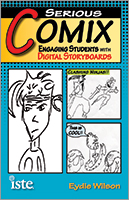More Why To than How To
Serious Comix: Engaging Students with Digital Storyboards
by Eydie Wilson
(ISTE, 2013 – Learn more)
When I saw the title of this small book – Serious Comix – I thought, that’s for me! Not only do I play around with comic creation myself, but I also bring elements of using comics for writing into my sixth grade classroom. We use an online webcomic site regularly and we often storyboard out our larger projects. So I was curious to see what Eydie Wilson was up to and wondered whether any of her ideas around using comics for writing might be adaptable for my classroom.

This is not necessarily the book to turn to if you are considering developing a unit around the use of comics for literacy (although she does share her lesson plans at the very end of the book). To its credit, though, Serious Comix does give some helpful insight into classroom engagement for students with learning difficulties, and Wilson provides a rationale for why comics make sense, particularly for struggling readers and writers.
Inside the book
Wilson defines “digital storyboards” as comics that are made with presentation technology – such as Powerpoint or Keynote – in that each slide becomes a frame of the comic. That makes a lot of sense, although what she doesn’t do is take that next step forward and explain how the multimedia aspects of those tools might open up digital composition in different directions.
What happens when you embed a video into your comic? Or how will the experience of writing and reading change when you add an audio track? Or how about animating some aspects of the comic so that it becomes a moving comic, and not just a static piece of writing and art? What about audience — embedding projects online for the world to see? These are the kinds of questions we need to be exploring so that the technology is not just another version of paper. Wilson never really goes in that direction here.
There is a lot of value in reading about the ways she creates an inclusive and collaborative small group environment, particularly in her tough New York City school. Her project involved just a handful of students in a computer lab that has outdated equipment, and Wilson refuses to shy away from the technological struggles she and her students encounter. Computers shut down unexpectedly, or take forever to boot up, or don’t work the way they should. Students learn about “saving” the hard way, although Wilson wisely turns one student’s experience of near loss of a project into a learning moment for everyone else.
What I wonder – What I like
One has to wonder how this would all translate into a full classroom experience. I liked how Wilson was very purposeful in the ways she establishes peer conversations, which she believes allows students to build trust, and then that trust leads to powerful stories created in a comic format.
I also like how she focuses on two particular students whose academic engagement seemed (evidence of progress is largely anecdotal) to thrive in other classes once they were fully engaged in her serious comix endeavor.
There are other books that give more tangible advice for creating a classroom where comics and digital comics are part of the literacy instruction. But Serious Comix is a nice addition to those conversations, reminding us how powerful the combination of art and writing can be for students who struggle with learning and engagement. The right environment, with the right tools and motivation, can lead to amazing projects by students across the spectrum.
(Kevin Hodgson also reviewed The Graphic Novels Classroom for MiddleWeb.)
Kevin Hodgson is a sixth grade teacher in Southampton, Massachusetts, and is the technology liaison with the Western Massachusetts Writing Project. Kevin has run summer camps for middle school students around webcomics, and he uses comics and graphic novels for reading and writing with his sixth graders. Kevin blogs regularly at Kevin’s Meandering Mind and tweets more often than is healthy under his @dogtrax handle.





































